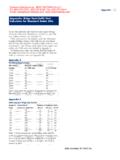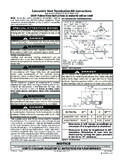Transcription of WEANING PROTOCOL - VentWorld
1 For Instructional Use Only (1/7) Fairview Southdale Hospital WEANING PROTOCOL Contact: Ted Wawrzyniak, BS, RRT, CPS, Fairview Southdale Hospital, Cardiopulmonary and Neurology Services Department 6401 France Avenue South, Edina, MN 55435-2199 Tel: (612) 924-5057, Fax: (612) 924-1514 Acknowledgements: Ted Wawrzyniak and Jason Stoen, the developers of this PROTOCOL , wish to thank all those at Fairview Southdale hospital who assisted with the PROTOCOL s development as well as a special thank you to Glen Thom, BS, RRT, Assistant Director of Respiratory Care at St. Alexius Hospital in Bismarck, ND. IMPORTANT NOTICE: THIS DOCUMENT IS PROVIDED BY FAIRVIEW SOUTHDALE HOSPITAL SOLELY FOR INSTRUCTIONAL PURPOSES. PROTOCOL Development, Application, and Use Ted Wawrzyniak May 24, 2000 PROTOCOL Development Jason Stoen and I developed the accompanying PROTOCOL .
2 We were looking for a new project to take on, and since we only had a standardized WEANING process for our heart patients, we thought it would be worth our efforts to develop a standardized process for all our vented patients. Based on the literature we read and the way vents were managed at our hospital, we felt that we could dramatically decrease ventilator times. We based most of our PROTOCOL on the Manthous article listed in my references section. If you want to develop a PROTOCOL , I strongly suggest reading that article as well as the others I have listed. Manthous and his colleagues believe the best approach to liberation from mechanical ventilation is to assess daily for WEANING readiness.
3 Once a patient is determined to be ready, they are placed directly on PS of 5. It was felt that by slowly turning down the support only wastes time. Most patients who are ready to be liberated from mechanical ventilation will be able pass this PS trial immediately. This PROTOCOL will separate those who are not able to do this and treat them a little differently. For those interested in the details, I suggest that you read the article and contact Jason or myself if you have any questions. PROTOCOL Application Currently, we are using it on all our patients who have a pulmonary consult. We are doing this so our medical director can oversee its implementation.
4 Once we get all the bugs worked out, we hope to present it to physicians other than pulmonologists. We are currently collecting data and will be able to compare ventilation times/length of stay of patients with and without the PROTOCOL . I will let you know what the results of this study are when it is finished hopefully before the end of the year. I haven t started looking at the data yet, but my initial observations For Instructional Use Only (2/7) Fairview Southdale Hospital and feedback from our pulmonologists is that RT s are being more aggressive with the WEANING process. We have noticed that patients who are ready to wean are on a PS of 5 and ABG results back before pulmonologists even make their AM rounds, eliminating the need to get orders for WEANING and then waiting for physicians to call back once we get the ABG s.
5 I also see it helping on weekends when we have on-call physicians making rounds who aren t familiar with our patients and our hospital policies. Some studies have shown decreased vent times by as much as 2-3 days, however this will largely depend on the patient population it is used on and the current ventilator management practice at you hospital. Using the PROTOCOL As far as the PROTOCOL itself, there is basically 3 parts to it. The first part is just some general guidelines. These may vary with your practice slightly, but for the most part are pretty much common sense. The next part is the WEANING readiness assessment part. This is where we start all our patients.
6 Depending on your patient population, a large majority won t need anything more than this part. The third part is the slow WEANING part. It is for those patients who get through the PROTOCOL and fail the last part (second diamond on the algorithm) for the second time. These patients are often COPDers who need to be weaned very slowly. At this point, the RTs have three choices. They can use a traditional SIMV wean, the PS slow wean, or the PRVC/VS (Pressure Regulated Volume Control/Volume Support) PROTOCOL . The PRVC/VS slow wean PROTOCOL was written solely for the Servo 300 ventilator, so unless you use Servo 300 s, you won t be able to use this one. The PRVC/VS PROTOCOL is the volume support PROTOCOL so many expressed interest in on the discussion board and could be incorporated into any existing PROTOCOL .
7 The PS slow WEANING PROTOCOL is a basic PS wean, put down in algorithm format. It was just done this way to standardize the PS WEANING process. Comments and Contact These are the algorithms we use at Fairview Southdale hospital in Minneapolis. You may want to use this as a guideline to customize one for your hospital based on the way you practice ventilator management. If there are any questions, please don t hesitate to call Jason Stoen or myself (Ted Wawrzyniak) at 612-924-5057. Probably a better way to get a hold of Jason is at or myself at For Instructional Use Only (3/7) Fairview Southdale Hospital GUIDELINES AND NOTES FOR EXTUBATION PROTOCOL 1. All patients with a pulmonary consult will be on this PROTOCOL .
8 2. Tube feedings should be stopped 1-2 hours before trial if TF is gastric and rapid WEANING PROTOCOL is being used. 3. All ventilator settings during rest periods are still to be managed by physicians. 4. We are required to document in progress notes at least once per shift and upon failed spontaneous breathing trails or other significant events. 5. Confirm dietary consult if the patient is on vent greater than 24 hours. 6. The patient must be on minimal BP drugs and have an acceptable blood pressure to start. 7. Nights should make sure nursing is preparing the patient for spontaneous breathing trails first thing in the morning before physicians make rounds (TFs, BP medications, sedations). 8. The patient should be stable before beginning trial. If there are any concerns about this, the physician should be called.
9 9. Return the patient to initial settings and document or call the physician if necessary if any time during the trial any of the following occur: a. Change in HR > 20 BPM, b. Change in BP > 20 mmHg, c. Unacceptable SpO2, d. Elevated RR beyond NL, e. VT < 5 mL/kg. 10. If WEANING PROTOCOL fails after the second attempt, try the other PROTOCOL . 11. At any time the physician may skip to the slow WEANING PROTOCOL . For Instructional Use Only (4/7) Fairview Southdale Hospital WEANING READINESS ASSESSMENT/ WEANING PROTOCOL 1. Not in shock. 2. PaO2 > 60 mmHg on FI02 < ; PEEP < 3. Resp. load not excessive; VE < 20 L/min. 4. On ventilator > 24 hours. 5. Minimal sedation (sedation for comfort but not to compromise ventilatory drive) Rest pt on original settings.
10 Re-evaluate in 24 hours. Re-Start TF if stopped 1. RVR < 120 on PS 5-8, PEEP 0-5 for 2-3 minutes. 2. Vitals stable. 1. Reduce resp. load: Reduce VC02 Infection? Overfeeding? Febrile? Bronchospasm/secretions? Reduce stiffness. Comatose/cough reflex. 2. Access for reversible causes of resp. muscle weakness: Sepsis electrolyte deficiencies, malnutrition. 3. See table for other reversible factors. 4. Diagnostic lab to assess and do metabolic cart if necessary. 5. Physical Therapy to assess? PS or T-piece breathing for hr on FI02 1. RVR < 105 2. HR increment < 20/min 3. BP increment < 20 mmHg 4. ABG with no acute resp. acidosis. 5. PaO2 > 60 mmHg. Second failure Do WEANING Param: Nif, VE, VC, VT, CL, RAW. Contact physician.







